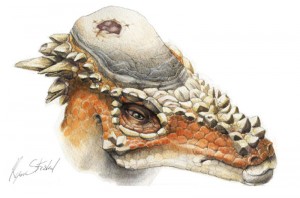Following on from the previous post, the afternoon symposium was all about the applications and implications of vertebrate taphonomy.
Matt Carrano kicked things off with a great talk on how microfossil bonebeds help to guide our understanding of terrestrial palaeoecosystems. Using sites from the well-known but poorly understood Cloverly Formation, he provided a key insight from abundances from terrestrial microsites into the composition of faunas. This was a particularly appealing talk for me as it contained atoposaurids!
Carina Colombi asked what the effect was of atmospheric CO2 on the evolution and preservation of the terrestrial fauna of the famous Ischigualasto Formation. It seems that decreases in atmospheric CO2 may explain decreases in the number of preserved vertebrate fossils in different horizons.
Tao Deng explored the taphonomy of the vertebrate fauna in the Linxia Basin in Gansu, China. Older individuals from particularly abundant rhino fossils seem preferentially preserved, based on ages inferred from tooth eruption
Adriana Mancuso described her research into taphonomic modes in a Triassic-Jurassic loessite (wind-blown deposit) from Patagonia. Different taphonomic regimes suggest aspects of social aggregation in some animals, for example from the accumulation of groups of juvenile specimens.
Alexander Parkinson gave an interesting talk on insect-bone interactions from the “Cradle of Humankind” in South Africa. There were plenty of types of boring trace, with a possible new ichnotaxon. The spatial distribution and mode of preservation of the fossils suggests extremely rapid burial and fossilisation.
Raymond Rogers brought us back to microfossil bonebeds, from the Upper Cretaceous Judith River Formation in the US. He was looking at huge numbers of fragmentary fossils and what their size and shape can tell us about their diagenensis, in particular how the deposits formed and where the fossils were sourced from.
Vijay Sathe discussed the taphonomy of a new large mammalian fauna from the Quaternary of India, and the possibility of their mode of death. It seems some may have fallen into pits, and subsequently scavenged by predators, with the preferential preservation of younger and older animals.
Leif Tapanila finished things off by looking at the effect of impermeable ash layers within geological basins, and whether their distribution affected the preservation potential of fossil layers by changing hydraulic regimes.
End of day 1! The best part for me of this second symposium was the potential that fossil microsites have in greatly increasing our understanding of diversity through time. Hopefully much more on this in the future.

